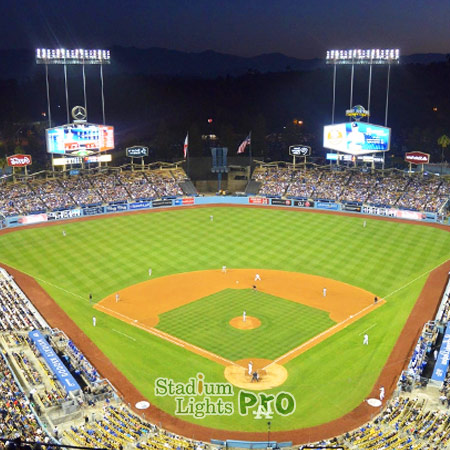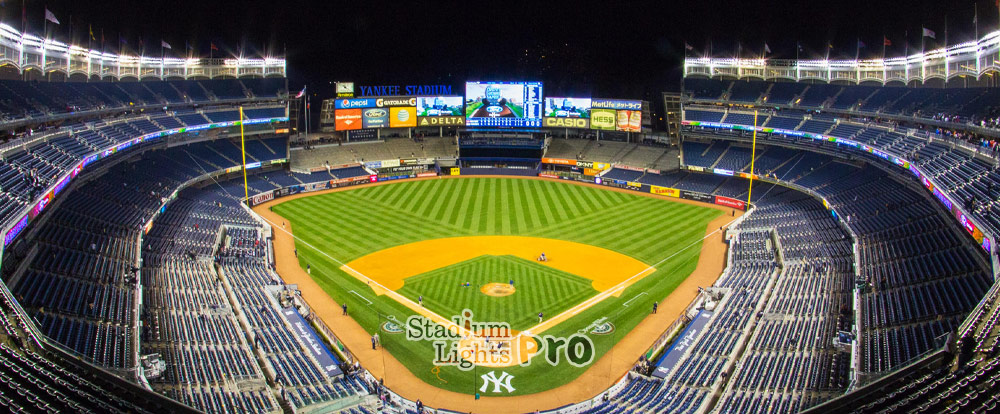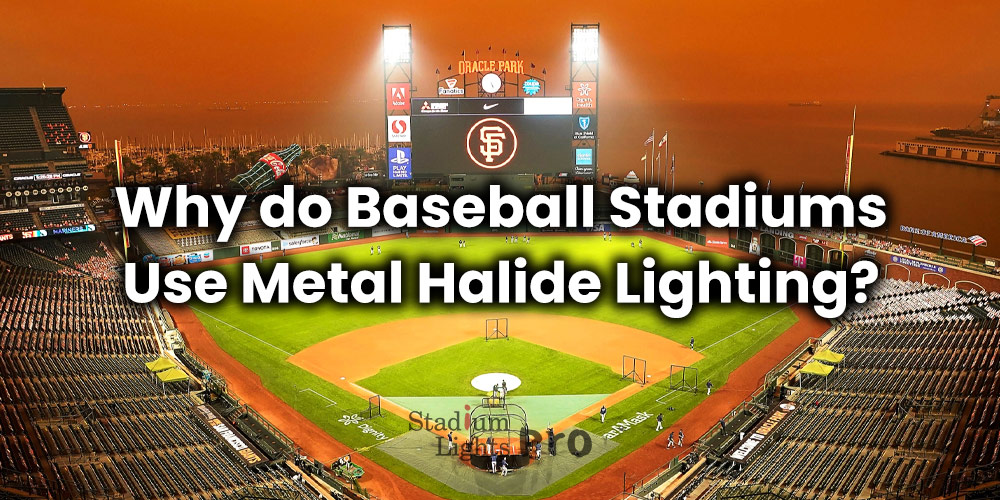Proper lighting is essential for baseball games, as it allows players to see the ball clearly and helps fans follow the action on the field. Metal halide lights have become a popular choice for baseball stadiums due to their unique characteristics, which provide superior visibility and color rendering. We will explore why baseball stadiums use metal halide lights, the benefits of this technology, and best practices for maintenance and replacement. We will also consider the environmental impact and sustainability of metal halide lights, as well as future trends and developments in baseball stadium lighting.
Table of Contents
ToggleWhat are metal halide lights?
Definition and description of metal halide lights
Metal halide lights are a type of high-intensity discharge (HID) lamp that produce light through a mixture of metal halides and mercury vapor. The lamp contains a quartz arc tube that is filled with a gas mixture and two tungsten electrodes. When an electric current is applied to the electrodes, an arc is created that vaporizes the gas mixture and produces light.
How they work and their characteristics
Metal halide lights have a number of characteristics that make them suitable for use in baseball stadiums. They produce a bright white light that closely resembles natural sunlight, providing excellent visibility for players and fans alike. They also have a high color rendering index (CRI), meaning that they accurately render colors and allow for better recognition of the ball and other objects on the field.
Advantages and disadvantages of using metal halide lights
Advantages of using metal halide lights in baseball stadiums include their high efficiency and long lifespan, which result in lower operating costs over time. They are also highly customizable, allowing for precise control over the lighting levels and distribution on the field.
However, there are some disadvantages to using metal halide lights, including their relatively slow warm-up time and the fact that they contain mercury, which can be harmful to the environment if not properly disposed of. Besides, metal halide lights tend to lose brightness over time and may require more frequent replacement compared to other lighting technologies.

Why baseball stadiums use metal halide lights?
Historical background of lighting in baseball stadiums
Early history of baseball stadium lighting
The first night game in professional baseball was played in 1935, with artificial lighting provided by banks of floodlights. Early lighting systems were often inadequate, with low levels of illumination and poor color rendering.
Development of new lighting technologies in the 20th century
Over the decades, new lighting technologies emerged, including incandescent bulbs, halogen lamps, and high-pressure sodium (HPS) lamps. Each technology offered different advantages and disadvantages for use in baseball stadiums.
Adoption of metal halide lights in modern baseball stadiums
Metal halide lights first began to be used in baseball stadiums in the 1980s and have since become the preferred technology due to their high efficiency, superior color rendering, and flexibility in terms of customization and control.
Comparison of metal halide lights with other lighting technologies
Incandescent bulbs and halogen lamps
These lighting technologies have been found to be inefficient and ineffective in producing high-quality color rendering, which makes them unsuitable for modern baseball stadium lighting. This means that they can result in low visibility, inconsistent lighting, and a reduced overall game experience for players and spectators. Furthermore, their energy consumption can be high, resulting in higher costs and less sustainability. As a result, many stadiums have opted to replace these outdated technologies with more advanced and efficient lighting solutions that offer improved color rendering, energy efficiency, and overall performance.
High-pressure sodium (HPS) lamps
HPS lamps have been known to provide high levels of illumination but have poor color rendering capabilities, which can result in reduced visibility and difficulty in recognizing objects on the field, including the ball. This can have a significant impact on the game experience for players and spectators alike, as well as on player safety. The color rendering index (CRI) of HPS lamps is typically low, meaning that colors may appear distorted or muted. This can make it difficult for players to distinguish between different objects on the field, such as the ball, the outfield wall, and the crowd.
HPS lamps are not very energy efficient, which can result in higher energy costs over time. For these reasons, many modern baseball stadiums have opted for more advanced lighting solutions that offer higher color rendering capabilities and energy efficiency, such as metal halide or LED lighting.
Light-emitting diodes (LEDs)
LEDs are gaining popularity in modern baseball stadiums because of their high energy efficiency, extended lifespan, and customizable features. These lighting solutions offer many benefits, including lower energy consumption, longer lifespan, improved color rendering, and reduced maintenance requirements. LEDs can be easily adjusted to provide precise and uniform illumination levels that can enhance the game experience for players and spectators alike.
Yet, the initial cost of installing LED baseball field lighting can be relatively high compared to other lighting technologies. Maintaining and repairing LED fixtures may require specialized equipment and expertise, which can add to the overall cost of ownership. Despite these considerations, many stadiums have found that the long-term benefits of LED lighting, including reduced energy costs and maintenance requirements, ultimately make them a worthwhile investment for modern baseball stadium lighting.
Benefits of metal halide lights in baseball stadiums
Improved visibility and color rendering
 Metal halide lights are preferred by many modern baseball stadiums due to their ability to produce a bright, white light that closely mimics natural sunlight. This feature allows for optimal visibility and color recognition, which is crucial for both players and fans in terms of safety, performance, and enjoyment of the game. With their high color rendering capabilities, metal halide lights are able to provide a more accurate representation of colors, making it easier for players to distinguish between different objects on the field, such as the ball, the uniforms, and the outfield walls.
Metal halide lights are preferred by many modern baseball stadiums due to their ability to produce a bright, white light that closely mimics natural sunlight. This feature allows for optimal visibility and color recognition, which is crucial for both players and fans in terms of safety, performance, and enjoyment of the game. With their high color rendering capabilities, metal halide lights are able to provide a more accurate representation of colors, making it easier for players to distinguish between different objects on the field, such as the ball, the uniforms, and the outfield walls.
Metal halide lights can create an immersive atmosphere that enhances the overall game experience for spectators. The bright and crisp illumination provides a clear view of the action, while also creating a visually appealing backdrop for the game. The white light produced by metal halide lamps can also help to reduce glare, which can be a safety hazard for players on the field.
Energy efficiency and cost-effectiveness
Metal halide lights are an efficient lighting solution for modern baseball stadiums. They offer a high level of brightness while consuming relatively low amounts of energy, making them a cost-effective option. Moreover, metal halide lamps have a long lifespan, reducing the need for frequent replacements and maintenance, which can further reduce operating costs over time.
Metal halide lights are known for their high energy efficiency. They are designed to convert electrical energy into light with minimal energy loss, resulting in bright illumination with low power consumption. This makes them a more environmentally friendly option than other lighting technologies that consume larger amounts of energy.
The long lifespan of metal halide lamps is another significant advantage, as it helps to minimize maintenance and replacement costs. With proper maintenance, metal halide lights can last for several years before needing to be replaced. This not only reduces the frequency of lamp replacements but also lowers the costs associated with labor and materials.
Flexibility and customization options
Metal halide lights are designed to provide precise control over the lighting levels and distribution on the field, which is crucial for providing optimal visibility for players and fans. With their ability to direct light in a specific direction, metal halide lights can be used to create uniform illumination on the playing surface, which is essential for maintaining safety and performance standards.
Moreover, metal halide lights offer a high degree of flexibility in terms of lighting design, which is crucial for creating unique lighting effects and customizations for special events and promotions. With advanced controls, metal halide lights can be programmed to change colors, dim, or strobe, creating exciting and dynamic lighting displays that add to the overall game experience.
The precision and flexibility of metal halide lights also allow stadium managers to control light pollution and minimize the impact of stadium lighting on the surrounding environment. By adjusting the angle and direction of the light, it is possible to reduce the amount of light spillage and glare, making metal halide lights a more environmentally friendly lighting solution.
Environmental impact and sustainability
Although metal halide lights do contain small amounts of mercury, proper disposal and recycling methods can mitigate the environmental impact. Many metal halide lamps are designed to be easily recyclable, and proper disposal practices can prevent mercury from being released into the environment. Besides, advancements in lamp technology have led to the development of low-mercury or even mercury-free metal halide lamps, further reducing the environmental concerns associated with their use.
Maintenance and replacement of metal halide lights

Metal halide lamps have a limited lifespan and will eventually need to be replaced. The lifespan of a metal halide lamp is typically around 15,000 hours of use, although this can vary depending on factors such as the quality of the lamp and the operating conditions of the stadium. When replacing metal halide lamps, it is highly recommended to choose a lamp with the same wattage, voltage, and color temperature as the existing lamp to maintain consistent lighting levels and color rendering.
Stadiums may choose to replace their metal halide lighting systems with newer, more energy-efficient technologies such as LED lights. However, this can be a costly and complex process that requires careful planning and execution.
Importance of regular maintenance and replacement
Safety
If metal halide lights are not properly maintained, they can become a safety hazard. Dirty lenses or reflectors can reduce the amount of light that reaches the field, making it harder for players to see the ball and increasing the risk of injury. Loose connections or wiring can also pose a fire hazard.
Performance
Metal halide lights that are not properly maintained can also suffer from reduced performance. They may produce less light, or the light they produce may be unevenly distributed, making it difficult for players to see the ball or for fans to follow the action.
Efficiency
Metal halide lights that are not properly maintained may consume more energy than necessary, leading to higher operating costs. By keeping the lamps and fixtures clean and in good working order, stadiums can help ensure that their lighting systems remain energy-efficient.
Lifespan
Metal halide lamps have a limited lifespan and will eventually need to be replaced. By performing regular maintenance, stadiums can help extend the lifespan of their lamps and delay the need for replacement, saving money in the long run.
Best practices for maintaining and replacing metal halide lights
To ensure that metal halide lights in baseball stadiums continue to provide optimal lighting conditions, stadiums should follow best practices for maintenance and replacement.
Regular cleaning
The lenses and reflectors of metal halide lights should be cleaned regularly to remove dirt and debris that can reduce light output and quality. This should be done using a soft cloth or brush, and a mild cleaning solution if necessary. Stadiums should also ensure that the surrounding area is kept clean to prevent debris from accumulating on the lights.
Routine inspections
Stadiums should conduct routine inspections of their metal halide lights to identify any issues before they become more serious. This includes checking for loose connections or wiring, inspecting the lamps for signs of wear or damage, and checking for any issues with the fixture or mounting hardware.
Timely replacement
Metal halide lamps have a limited lifespan and will eventually need to be replaced. Stadiums should keep track of the age and usage of their lamps, and replace them in a timely manner to ensure consistent lighting levels and color rendering. When replacing lamps, stadiums should choose a lamp with the same wattage, voltage, and color temperature as the existing lamp.
Consider upgrading
While metal halide lights are a proven technology, newer lighting technologies such as LED lights may offer improved energy efficiency, longevity, and color rendering. Stadiums should consider upgrading their lighting systems to take advantage of these benefits, but should do so with careful planning and consideration of the costs and benefits involved.
Costs and considerations for baseball field lighting replacement
The costs and considerations for replacing metal halide lights in a baseball stadium can vary depending on several factors, including the size of the stadium, the number of lights to be replaced, and the type of replacement technology chosen. Here are some assumptions and cost ranges to consider:
- A typical baseball stadium has around 100 metal halide lights.
- The cost of labor is not included in the cost estimates.
- The cost of electrical work is not included in the cost estimates.
Metal halide replacement
If replacing metal halide lights with new metal halide lights, the cost could range from $100-$500 per lamp depending on the wattage and quality of the lamps. This would result in a total cost of around $10,000-$50,000 for a stadium with 100 lights.
Considerations
This option may not offer significant energy savings or improved performance over the existing metal halide lights.
LED replacement
Replacing metal halide lights with LED lights may result in a total cost ranging from $40,000 to $100,000 for a stadium with 100 lights, depending on the quality and wattage of the LEDs. The cost per lamp could range between $400 and $1,000.
Considerations
LED lights can offer significant energy savings, improved color rendering, and a longer lifespan than metal halide lights. However, the upfront cost may be higher and additional electrical work may be needed to accommodate the new fixtures.
Apart from the cost of the replacement lights, stadiums should also consider the cost of labor and electrical work, which can vary depending on the complexity of the installation and the local labor rates. Stadiums may also need to consider the potential impact on the playing surface, as new fixtures may require supplementary structural support that could affect the field of play.
Conclusion
Metal halide lights have been a popular choice for many years due to their bright and consistent lighting, but they do have some drawbacks such as high energy consumption and frequent maintenance needs. However, with the advancements in LED technology, many stadiums are considering upgrading to more energy-efficient and sustainable lighting options. While the upfront costs may be higher for LED replacements, the long-term benefits may make it a worthwhile investment.
We invite you to contact us for more information on metal halide light replacement for baseball fields. Our team of lighting experts is here to assist you in finding the best replacement options that will enhance your stadium’s performance and sustainability. We offer free lighting design services that are tailored to your specific needs, ensuring that your replacement fixtures are appropriately sized and optimally placed. Our experts will also provide replacement tips to help you maintain your new fixtures and maximize their lifespan. Don’t hesitate to reach out to us for assistance in upgrading your stadium lighting.

